WeaveResearch Unit: Home (original) (raw)
Weaver species
Choose different species from drop-down list and press 'Go' button. See Full species list.
Holub's Golden Weaver Ploceus xanthops
IUCN: Least concern Discovery: 063
Categories: golden, wetland, fruit, gum, Gymnogene, nectar, pest, Nest use, palm,
News items about species
Discovery
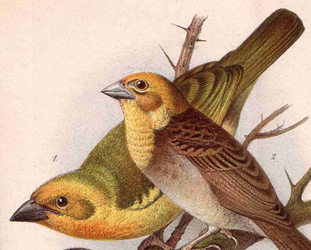
Holub's Golden Weaver adult,
figure from Reichenow (1886)
(Sakalava Weaver in front)

Holub's Golden Weaver
variation in eggs (circled)
figure from Swynnerton (1916)

Holub's Golden Weaver
distribution, type locality circled
Introduction
Holub's Golden Weaver was formally described by Karel Johan Gustav Hartlaub, a German physician and ornithologist.
Holub's Golden Weaver had been collected by Joachim John Monteiro, a Portuguese engineer and ornithologist. Hartlaub described several birds that Monteiro collected in Angola in 1861, but no localities were provided. A century later, hall collected birds in Angola and in studying variation in plumage and size in Holub's Golden Weaver, restricted the type locality to the lower Cuanza River in northern Angola.
Over the next few years, many Holub's Golden Weaver specimens were collected in Angola and Western Africa. It was only 20 years after its discovery, that it was also found in southern Africa (in Botswana).
The first illustration of the Holub's Golden Weaver was of a male, published by Reichenow (1886). The next illustrations pertaining to Holub's Golden Weaver were by Swynnerton (1916), showing the mouth parts of chicks and also the variation in egg colour of the eggs.
Scientific citation
Hyphantornis xanthops Hartlaub 1862 Ibis, p.342 Angola. Restricted to "Lower Cuanza River" by Hall (1960, Bull. Brit. Mus. (Nat. Hist.), 6, p.447).
Meaning of names
xanthops Greek: xanthos, yellow; ops, the face or appearance.
First English name
Golden-faced Weaver Bird (Layard 1884).
Alternate names
African Golden Weaver, Camburn's Golden Weaver, Golden Weaver, Hartlaub's Golden Weaver, Jameson's Golden Weaver, Large Golden Weaver, Mashona Larger Golden Weaver, Olive-backed Weaver.
Collector
Joachim J Monteiro.
Date collected
Locality collected
Angola = lower Cuanza River.
Type specimens
The type specimen was in the British Museum (BM 1873.12.10.4).
The above is based on Weaver Wednesday 2, a weekly series about the discovery of each weaver species.
This species text first appeared as Weaver Wednesday [180] - Discovery [63]: Holub's Golden Weaver on 2015-11-25
1. Basic biology
Holub's Golden Weaver male
**Identification.**The Holub's Golden Weaver is a golden yellow weaver, larger and heavier-billed than the Eastern Golden Weaver, and the eye is pale yellow, not red. The sexes are similar but males have an orange wash on the throat and upper breast (photo right) - other sympatric golden weavers have the whole head orange. Juveniles have longer tails than other similar juvenile weavers.
**Distribution.**Holub's Golden Weaver is found in Congo, DRC and Angola, and from East Africa south to KwaZulu-Natal, South Africa (see map below, based on Birds of Africa). No large-scale range changes are apparent and no subspecies of the Holub's Golden Weaver are recognised.
**Habitat.**The Holub's Golden Weaver inhabits bushy areas interspersed with tall grass: it likes forest margins, woody savanna and dense vegetation along watercourses and stream lines. This species occurs mainly singly and in pairs, but may roost in flocks. Anting has been recorded.
**Food.**Holub's Golden Weavers feed on a variety of food including insects, berries, fruits, green and ripe seeds of grasses, seeds and nectar. They extract grubs from pods. Termite alates are caught on the ground or on the wing. Young are fed on spiders and insects like grasshoppers, praying mantises, and tabanid flies. 
Like many weaver species, the longevity record is over 10 years (see here).
**Breeding.**The Holub's Golden Weaver is a territorial, monogamous, semi-colonial nester. Two or three territorial males often breed in a loose colony of 2-5 nests each. The male builds several nests (photo below) but usually only one is used for eggs. The breeding season is Jan-Apr over much of its range.
The nest is a large, bulky, kidney-shaped structure, with no spout but usually with a 'veranda' of seed-heads protruding from the entrance on the underside. The nest is woven of coarse, broad-bladed grass. Breeding nests are lined with grass heads and stems and sometimes a few feathers. The nest is usually suspended from its roof. Sometimes it is slung between reeds or supported at one side by a reed; or placed in tall bushes amongst elephant grass, on drooping tips over water, and in reedbeds.
Colony size varies from 1 - 4.3 - 15 (n=19). Nests are mostly built in trees (n=42), but also in reeds (n=4) and mixed sites (n=3). In contrast, a study in Zimbabwe, counted 54 nests in reeds and 43 in trees. Also look out for old nests which may be used by a variety of birds like Orange-breasted Waxbill Amandava subflava, and even by Woodland Mouse Grammomys dolichurus.
Holub's Golden Weaver adult at nest
Holub's Golden Weaver colony
The above is based on Weaver Wednesday, a weekly series about weaver species.
This species text first appeared as Weaver Wednesday [33]: Holub's Golden Weaver on 2013-01-30
2. Breeding facts
Pair bond
Monogamous
Breeding season
Jan-Apr over much of range; as early as Sept in S Africa, Zambia and Malawi and recorded in most months in E Africa, peak season Aug-Oct in Uganda
Nest site
usually suspended by roof 2-2.5 m up from tall bush or reeds, often over water, rarely slung between reeds or supported at one side only; leaves stripped from vegetation surrounding nests
Nest building
built by male, female contributing lining
Colony size
Often loose colony of two or three territorial males; several nests built in territory but only one occupied
Clutch size
1-3 eggs, most often 2 (Malawi)
Egg colour
plain blue, white or pinkish, or evenly freckled with red and lilac
Egg size
average size of 55 eggs 24.1 x 16.2 mm (S Africa)
Incubation
incubation 14-15 days, 14 days in captivity
Chicks and nestling period
chicks fed by both sexes, nestling period 19-22 days
Breeding information based on Handbook of the Birds of the World, Vol. 15.
3. Photos of Weaver Nests
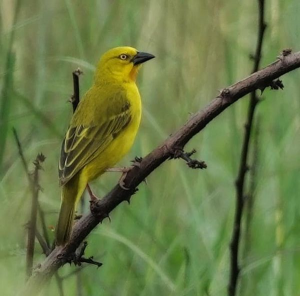 Vm 31024 Vm 31024 |
 Vm 29685 Vm 29685 |
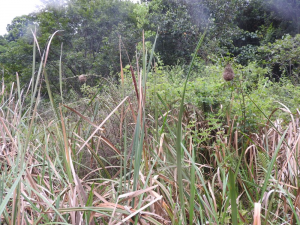 Vm 29684 Vm 29684 |
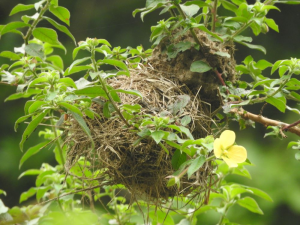 Vm 29683 Vm 29683 |
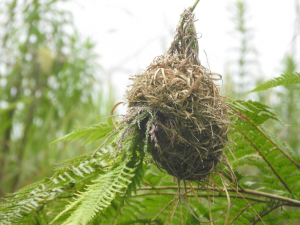 Vm 29681 Vm 29681 |
 Vm 29624 Vm 29624 |
|---|
Thumb-nails of most recent PHOWN records - click on one to see its full record
See all PHOWN records for this species here.
PHOWN (Photos of Weaver Nests) provides valuable info on breeding distribution and colony sizes of weavers.
You can contribute by registering and submitting photos at Virtual Museum webpage.
4. Breeding distribution
Google map showing distribution (For species with small ranges you need to zoom in at the correct area to see the range):
yellow blob - range of weaver species; read more about this here. - PHOWN records with photos
- PHOWN records with photos - PHOWN records with no photos (Nest Record Cards, other records)
- PHOWN records with no photos (Nest Record Cards, other records) - Birdpix records
- Birdpix records - comments on out of range records, or interesting records
- comments on out of range records, or interesting records - type locality
- type locality
CLICK on the marker on the map to see individual record details.
5. Range changes
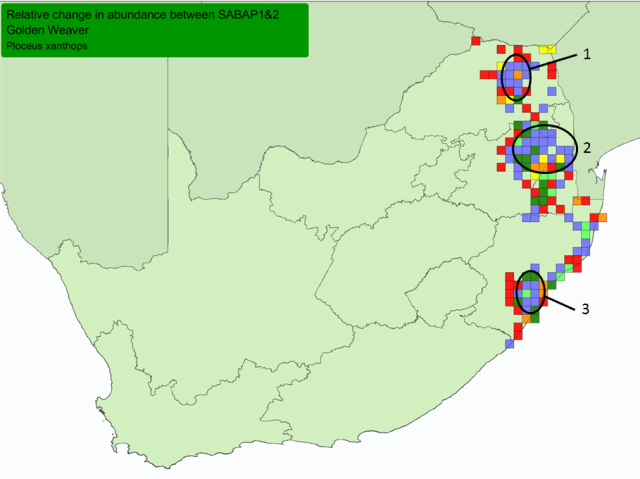
Holub's Golden Weaver, Range-change map between SABAP1 (1987-1991) and SABAP2 (2007-current).
Red, orange and yellow = cells with very large, large, and small relative decreases
Blue, dark green and light green = cells with very large, large and small relative increases.
Cells = quarter-degree grid cells; Only cells with at least 4 checklists in both SABAP1&2 shown. All cells had this species recorded in SABAP1 or in SABAP2 or in both (more about interpretation at Biodiversity Observations 7.62: 1-13).
Holub's Golden Weaver,
figure from Birdpix
Range changes in SA
| Range change summary | ||||
|---|---|---|---|---|
| More | 4 lists | 30 lists | ||
| increases | n | % | n | % |
| Decrease | 49 | 34 | 34 | 33 |
| Tiny change | 17 | 12 | 14 | 14 |
| Increase | 76 | 53 | 55 | 54 |
| Total | 142 | 100 | 103 | 100 |
In South Africa the Holub's Golden Weaver has many more grid cells with increases in reporting rate than cells showing decreases, between SABAP1 (1987-1991) and SABAP2 (2007-).
The points below match the points on the map above.
Areas with very large increases include:
1. Limpopo province.
2. Mpumalanga, centered on Nelspruit (also the core of its range in South Africa).
3. KwaZulu-Natal midlands.
Areas with very large decreases:
On the edges of its range in South Africa, particularly around the areas of high increases in Limpopo (no. 1) and the western edge of the KwaZulu-Natal midlands (no. 3).
Range changes elsewhere
None known.
The above is based on Weaver Wednesday 3, a weekly series about range changes in South African weaver species.
This species text first appeared as Weaver Wednesday 3 [249] - Range changes [12]: Holub's Golden Weaver on 2017-03-22



